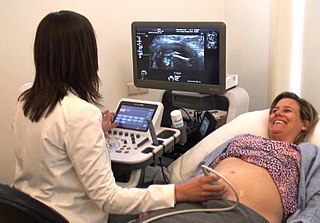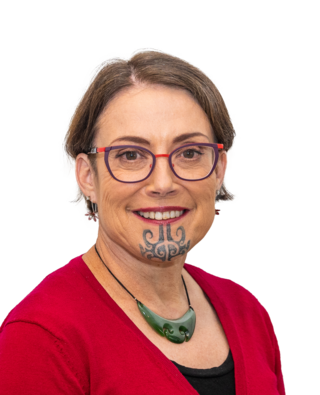
Midwifery is the health science and health profession that deals with pregnancy, childbirth, and the postpartum period, in addition to the sexual and reproductive health of women throughout their lives. In many countries, midwifery is a medical profession. A professional in midwifery is known as a midwife.
Obstetrics is the field of study concentrated on pregnancy, childbirth and the postpartum period. As a medical specialty, obstetrics is combined with gynecology under the discipline known as obstetrics and gynecology (OB/GYN), which is a surgical field.

Sudden infant death syndrome (SIDS), sometimes known as cot death, is the sudden unexplained death of a child of less than one year of age. Diagnosis requires that the death remain unexplained even after a thorough autopsy and detailed death scene investigation. SIDS usually occurs during sleep. Typically death occurs between the hours of midnight and 9:00 a.m. There is usually no noise or evidence of struggle. SIDS remains the leading cause of infant mortality in Western countries, constituting half of all post-neonatal deaths.
A birthing center is a healthcare facility, staffed by nurse midwives, midwives and/or obstetricians, for mothers in labor, who may be assisted by doulas and coaches. The midwives monitor the labor, and well-being of the mother and the baby during birth. Doulas can assist the midwives and make the birth easier. Should additional medical assistance be required, the mother can be transferred to a hospital. This transfer is more likely if an epidural is needed, there is meconium staining, it is a prolonged labor, or the newborn needs intensive care. Some hospitals have birth centers as an alternative to the usual high tech maternity wards.

Episiotomy, also known as perineotomy, is a surgical incision of the perineum and the posterior vaginal wall generally done by an obstetrician. This is usually performed during the second stage of labor to quickly enlarge the aperture, allowing the baby to pass through. The incision, which can be done from the posterior midline of the vulva straight toward the anus or at an angle to the right or left, is performed under local anesthetic, and is sutured after delivery.

The postpartum period begins after childbirth and is typically considered to last for six weeks. There are three distinct phases of the postnatal period; the acute phase, lasting for six to twelve hours after birth; the subacute phase, lasting six weeks; and the delayed phase, lasting up to six months. During the delayed phase, some changes to the genitourinary system take much longer to resolve and may result in conditions such as urinary incontinence. The World Health Organization (WHO) describes the postnatal period as the most critical and yet the most neglected phase in the lives of mothers and babies; most maternal and newborn deaths occur during this period.
A home birth is a birth that takes place in a residence rather than in a hospital or a birthing center. They may be attended by a midwife, or lay attendant with experience in managing home births. Home birth was, until the advent of modern medicine, the de facto method of delivery. The term was coined in the middle of the 19th century as births began to take place in hospitals.
The American Academy of Pediatrics (AAP) is the largest professional association of pediatricians in the United States. It is headquartered in Itasca, Illinois, and maintains an office in Washington, D.C. The AAP has published hundreds of policy statements, ranging from advocacy issues to practice recommendations.
The Ferber method, or Ferberization, is a technique invented by Richard Ferber to solve infant sleep problems. It involves "sleep-training" children to self-soothe by allowing the child to cry for a predetermined amount of time at intervals before receiving external comfort.
Sally Tracy is an Australian midwife, midwifery researcher, author and activist. She has authored numerous research articles. In 2023, she was appointed as a Member of the Order of Australia.

The Safe to Sleep campaign, formerly known as the Back to Sleep campaign, is an initiative backed by the US National Institute of Child Health and Human Development (NICHD) at the US National Institutes of Health to encourage parents to have their infants sleep on their backs to reduce the risk of Sudden Infant Death Syndrome, or SIDS. The target age group of the campaign is 0–1 years of age, because this is when babies are at the greatest risk of experiencing SIDS. Since "Safe to Sleep" was launched in 1994, the incidence of SIDS has declined by more than 50%. However, there has been a rise in infant sleep-related suffocation events. Consequently, the campaign has broadened its goal to focus on safe sleep conditions and further preventative measures.
Psychiatric disorders of childbirth, as opposed to those of pregnancy or the postpartum period, are psychiatric complications that develop during or immediately following childbirth. Despite modern obstetrics and pain control, these disorders are still observed. Most often, psychiatric disorders of childbirth present as delirium, stupor, rage, acts of desperation, or neonaticide. These psychiatric complications are rarely seen in patients under modern medical supervision. However, care disparities between Europe, North America, Australia, Japan, and other countries with advanced medical care and the rest of the world persist. The wealthiest nations represent 10 million births each year out of the world's total of 135 million. These nations have a maternal mortality rate (MMR) of 6–20/100,000. Poorer nations with high birth rates can have an MMR more than 100 times higher. In Africa, India & South East Asia, as well as Latin America, these complications of parturition may still be as prevalent as they have been throughout human history.

A midwife is a health professional who cares for mothers and newborns around childbirth, a specialization known as midwifery.

A bedside sleeper, also referred to as a sidecar sleeper or bedside bassinet, is a bassinet or baby cot that attaches to the parents' bed, allowing newborns to sleep next to their parents safely. This is a form of safe co-sleeping, and has little risks associated with sudden infant death syndrome, unlike bedsharing. Bedside sleepers are a component of rooming-in, a practice followed in hospitals to keep the baby by the mother's bed, giving her time to establish a stronger bond with her baby.
Dawn Elizabeth Elder is a New Zealand academic and paediatrician. As of 2018, she is a full professor and head of department at the University of Otago, Wellington.
Judith McAra-Couper is a New Zealand academic and a professor of midwifery at Auckland University of Technology.
Caroline Susan E. Homer is an Australian midwifery researcher and international advocate for women's health rights. She is Co-Program Director, Maternal and Child Health at the Burnet Institute in Melbourne and Visiting Distinguished Professor of Midwifery at the University of Technology Sydney.

George Ian TownFRACP is a New Zealand respiratory scientist and health official. He was appointed the Chief Science Advisor to the New Zealand Ministry of Health in 2019.
Barbara Carolyn Galland is a New Zealand academic in the field of paediatric sleep health. She is a professor in the department of women's and children's health at the University of Otago.

Suzanne Marie Crengle is a New Zealand Māori academic, of Kāti Māmoe, Kāi Tahu and Waitaha descent and as of 2020 is a full professor at the University of Otago, specialising in public health medicine.








